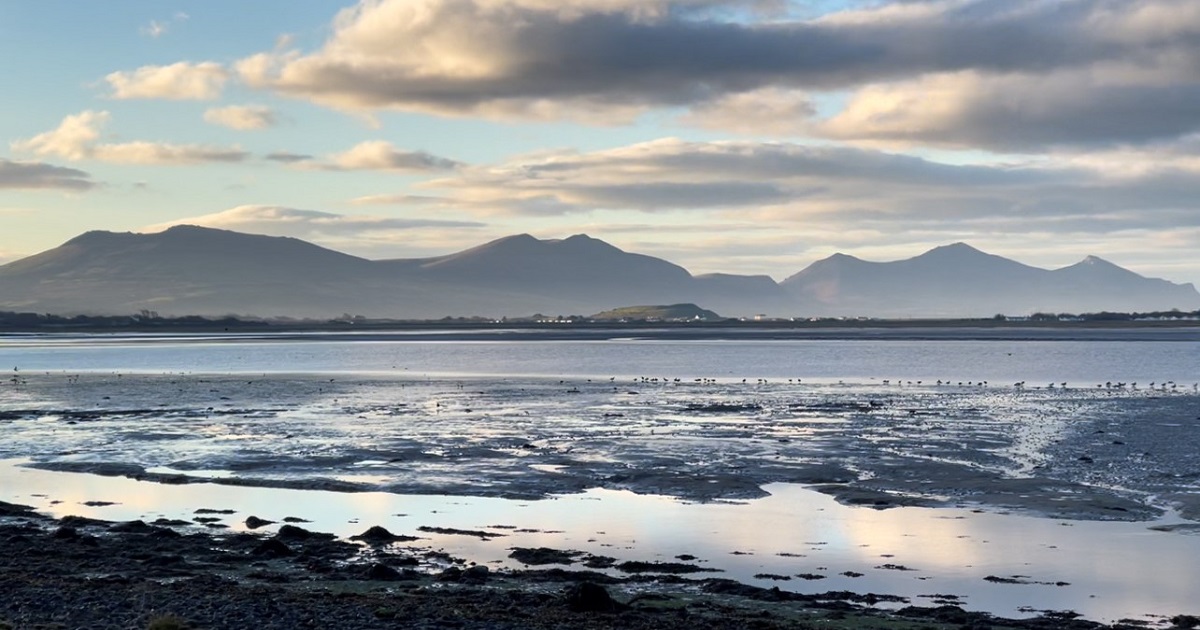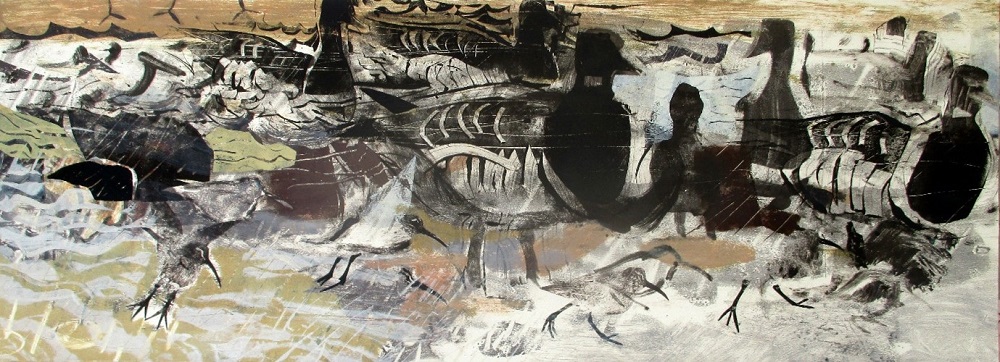Letter from the Foryd estuary

Elinor Gwyn
Travellers and Crossings
I feared the magical Foryd estuary, at the western end of the Menai strait, would be a quieter and emptier place this winter due to the outbreak of a highly pathogenic strain of avian influenza that swept through wild bird populations in 2022.
Mesmerising
On a golden, late December afternoon I ventured down to the shore at mid-tide, hoping to see once again the small salt-and-pepper coloured Brent geese (Branta bernicla) that spend the autumn and winter months along this mesmerising stretch of coast, feeding mainly on the Caernarfon side of Afon Menai at low tide and roosting at high tide on the opposite shore – on Anglesey’s Traeth Melynog (or Braint estuary).
Two subspecies of these neat birds, only slightly larger than a mallard, find their way back here every year: the dark-bellied Brent geese make the journey from their nesting areas in northern Russia and Siberia, while the pale-bellied Brent geese travel from their breeding grounds in Svalbard and Greenland.
These dark little geese (‘gwydd ddu/gwyddau du (pl)’ in Welsh) were once rare visitors to North Wales, but have gradually increased in numbers since the late 1980s. Their numbers are currently stable, but with only 30-50 of the dark-bellied subspecies, and 300-400 of the pale-bellied birds present every winter it is still feels a rare and special treat to catch sight of them along this shoreline between September and April.

The wildlife artist, Kim Atkinson, brilliantly captures the atmosphere of the Foryd estuary and its winter inhabitants in her evocative monoprint that gives centre stage to the birds – with the dunlin in the foreground flying into shelter in a squall, as if they were hiding behind the Brent geese as Kim explained.
There were no squalls on that December afternoon I spent wandering along the edge of the Foryd estuary. It was a still, still day.
The only sounds were the chortling of the Brent geese, apparently unaffected by the bird flu according to local ornithologists, interspersed with the tumbling calls of curlews, the cawing of crows and the piping, chirrucking sounds of turnstones as they scurried and scrabbled along the seaweed covered, cobbly shoreline.
Desolation
The following day I was at the National Library of Wales in Aberystwyth, reading about Joseph Huck’s attempt at crossing the vast Traeth Lafan, at the eastern end of Afon Menai, back in 1794. The journey was but a tiny fraction of the long-haul flight of the Brent geese but sounded just as perilous, even in July.
Travelling with his companion Samuel Taylor Coleridge he set off on the four-mile walk across the “frightful desert without shoes or stockings” towards the “dirty sea-faring town of Beaumaris” and the island of Anglesey, which he ultimately found disappointing – indeed a picture of desolation, exacerbated by the excessive heat of the summer.
Keeping the ferryman’s white house in view on the Anglesey shore, as advised by a local vicar, the group started on the journey from Abergwyngregyn. His account describes the terrifying ordeal as the mist descended thickly around them, dissolving the land into cloud and confusing their sense of direction.
Alarmed
As darkness overtook them they could see or hear nothing, “except the noise which the sea made in its approach, that alarmed us not a little; at length, to our infinite satisfaction, we distinguished the voices of the ferrymen, who were luckily waiting on this side of the passage.
When they heard us, they were extremely impatient for our arrival, and continually called us to make haste…we therefore made towards the spot from whence the sounds came….but were unluckily interruped by a small channel, already filling very fast with the sea. We did not hesitate long, for in fact we had no alternative, and therefore boldly ventured through…
We congratulated each other upon finding ourselves safe in the boat, though dripping wet and shivering with cold”.
I could not help wondering what the tireless feathered visitors to the Foryd estuary, as well as the fearful 18th century tourists who had no choice but to navigate treacherous sands and uncertain ferry crossings across Afon Menai, would make of the constant gripes about twenty minute delays over the Britannia Bridge over the past few months while the Menai Bridge has been closed for safety reasons. If only they knew!
**********
Diolch – thank you, to Kim Atkinson for allowing the monoprint of the Dunlin and Brent Geese to be used for this article, and to Simon Hugheston-Roberts for sharing the latest information on the Brent Geese.
You can discover other ‘Letters from’ on Nation.Cymru by following the links on this map
Support our Nation today
For the price of a cup of coffee a month you can help us create an independent, not-for-profit, national news service for the people of Wales, by the people of Wales.






